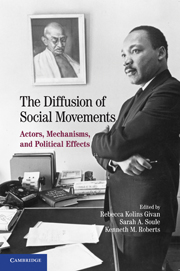Book contents
- Frontmatter
- Contents
- List of Tables
- List of Figures
- Contributors
- Preface and Acknowledgments
- 1 Introduction: The Dimensions of Diffusion
- PART I DIFFUSION AND THE FRAMING OF CONTENTIOUS POLITICS
- PART II MECHANISMS OF DIFFUSION
- PART III DIFFUSION, SCALE SHIFT, AND ORGANIZATIONAL CHANGE
- 10 From Protest to Organization: The Impact of the 1960 Sit-Ins on Movement Organizations in the American South
- 11 Dynamics of Diffusion: Mechanisms, Institutions, and Scale Shift
- General Bibliography
- Index
10 - From Protest to Organization: The Impact of the 1960 Sit-Ins on Movement Organizations in the American South
Published online by Cambridge University Press: 05 June 2012
- Frontmatter
- Contents
- List of Tables
- List of Figures
- Contributors
- Preface and Acknowledgments
- 1 Introduction: The Dimensions of Diffusion
- PART I DIFFUSION AND THE FRAMING OF CONTENTIOUS POLITICS
- PART II MECHANISMS OF DIFFUSION
- PART III DIFFUSION, SCALE SHIFT, AND ORGANIZATIONAL CHANGE
- 10 From Protest to Organization: The Impact of the 1960 Sit-Ins on Movement Organizations in the American South
- 11 Dynamics of Diffusion: Mechanisms, Institutions, and Scale Shift
- General Bibliography
- Index
Summary
For the past three decades, scholars of social movements have debated whether collective protest is the product of prior organization, as predicted by resource mobilization and political process theories. In this chapter, we consider the other side of this relationship: whether the diffusion of protest leads to the growth of movement organizations. This tackles the third question posed by Givan, Roberts, and Soule in the introduction to this volume: What is the impact of diffusion? This question is rarely asked, as studies of diffusion devote much greater attention to the onset and spread of innovations than to their long-term consequences (Soule 2004; Strang and Soule 1998). Although the consequences of the diffusion of protest for movement organization have attracted remarkably little attention, various theories converge on the prediction that the effect will be positive. People drawn into protest are available to be recruited as new members, and activists have reason to consolidate the enthusiasm of defiance by expanding existing organizations or founding new ones.
This chapter considers a historically and theoretically influential case: the 1960 sit-ins by black college students in the American South. The sit-ins have been credited with revitalizing a civil rights struggle that had been floundering in the late 1950s. Local campaigns were set in motion, new leaders emerged, established organizations increased their efforts, and a new organization was created – the Student Nonviolent Coordinating Committee (SNCC).
- Type
- Chapter
- Information
- The Diffusion of Social MovementsActors, Mechanisms, and Political Effects, pp. 187 - 203Publisher: Cambridge University PressPrint publication year: 2010
- 6
- Cited by



